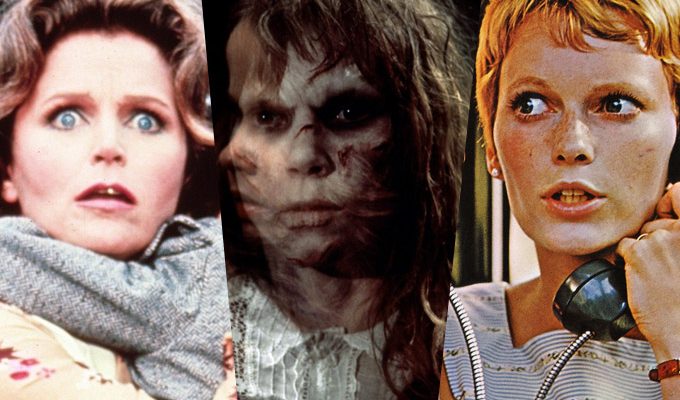 Popol Vuh —“Nosferatu the Vampyre” (1979)
Popol Vuh —“Nosferatu the Vampyre” (1979)
When it comes to avant-garde collaborations, Werner Herzog and Florian Fricke, the main man behind German electronic band Popol Vuh, coyly dances near our number one spot. “Aguirre, Wrath Of God,” Fricke’s first soundtrack for Herzog, may come most quickly to mind, but the indelible power of his work on “Nosferatu the Vampyre” feels like it would be blasphemous to overlook. A central touchpoint for all gothic horror scores, it’s also a score that is completely sustainable on its own without the film’s context, but which enhances it in grand, billowing fashion. Elements from Popol Vuh’s stand-alone albums combine with creative inspirations from Georgian folk songs to create something perplexing, minacious and mystical all at once. Sitars and theremins all play their part in a celestial struggle between good and evil, light and dark, electric and acoustic, ending up in a knife-edge balance between eternally ancient and experimentally new.
 François-Eudes Chanfrault —“Inside” (2007)
François-Eudes Chanfrault —“Inside” (2007)
Happily for horror fans, 21st century world cinema has been bathed in blood, not least due to of a handful of immensely violent horror films from France. Amid the sheer grossness, boundless cruelty and chaos of movies like “Martyrs” and “Frontier(s),” what’s often forgotten is the films’ music, which can makes things a little more artfully scary as in François-Eudes Cahnfrault’s score for “Inside,” likely the most brutal of all the recent extreme French horrors. Atmospheric and subtle during periods of suspense and synthetically distorted in its many WTF moments, it also features a main theme so strikingly beautiful with its string compositions that it almost makes you forget all the different ways a sewing needle is used in the movie. Chanfrault’s already contributed tremendous work to contemporary French horror on Alexandre Aja‘s “High Tension,” but he out-composes himself here, creating music that literally sounds like it was conducted from the inside of a doomed womb.
 Mica Levi – “Under The Skin” (2013)
Mica Levi – “Under The Skin” (2013)
In general, we’ve tried to steer away from the best latter-day horror scores, as it’s always hard to know the extent to which any work will withstand the test of time. But Mica Levi’s music for Jonathan Glazer’s stunning sci-fi horror “Under The Skin” is so innovative and unsettling that we’re sure we’ll be talking about it not just ten years from now, but in 2065. The first film work from the terrifyingly young Levi, the score is both organic and alien, as woozy as a dream and as persistent as a nightmare, living up to the title and digging into your very bones and remaining there for days. At times, it feels like Levi has used otherworldly instruments, their pitch-shifting and distortion ensuring that even when you hear something that could be strings or percussion, it might also be something originating from beyond the stars. An instant classic.
 Tindersticks – “Trouble Every Day” (2001)
Tindersticks – “Trouble Every Day” (2001)
The unlikely but persistent collaboration between ace French director Claire Denis and Britain’s indie stalwarts Tindersticks has been one of the most fruitful between a filmmaker and musicians in the last few decades, with five scores resulting thus far. Perhaps the most atypical is their second team-up (and last before the band disbanded for much of the ’00s) for Denis’ brutal horror flick “Trouble Every Day.” A fascinating, existential sex-fuelled thriller that digs into Denis’ most familiar concerns while still feeling rooted in genre, the film opens with the title song, a more traditionally lush piece from the band. But the film and score set out to unnerve after that: they’re not reinventing their own wheel, but the minimalist mix of strings and percussion works beautifully at throwing you off balance and works particularly well given how different it sounds from the vast majority of horror scores.
 David Lynch & Alan Splet — “Eraserhead” (1977)
David Lynch & Alan Splet — “Eraserhead” (1977)
Aside from the occasional “Straight Story,” Lynch’s work has always been tinged with horror. But 1977’s “Eraserhead” is the most fully of the genre of his oeuvre and boasts one of the eeriest soundtracks, composed by Lynch himself along with the late Alan Splet. His fever-nightmare of a debut is less a traditional musical soundtrack (aside from a few brief organ jams from Fats Waller) than an ambient delve into the mind of both its central character and the film’s director. The score fits Lynch’s images impeccably, but that doesn’t mean you can’t listen to it on its own, with its cohesive and rich soundscape somehow taking on a hypnotic musicality despite having few real melodies (the radiator girl’s song being another brief exception). Also a major shout out to Angelo Badalamenti‘s unnerving work on “Blue Velvet” and “Mulholland Drive” which show Lynch’s flair for music when he’s not composing.

